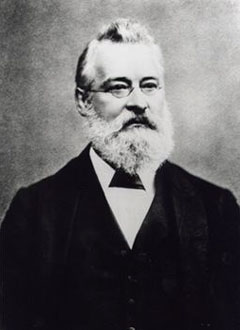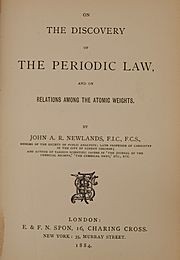John Newlands facts for kids
Quick facts for kids
John Newlands
|
|
|---|---|
 |
|
| Born | 26 November 1837 Lambeth, London, England
|
| Died | 21 July 1898 (aged 60) Lower Clapton, Middlesex, England
|
| Alma mater | Royal College of Chemistry Imperial College London |
| Known for | Periodic table, law of octaves |
| Awards | Davy Medal (1887) |
| Scientific career | |
| Fields | Analytical chemistry |
John Alexander Reina Newlands (born November 26, 1837 – died July 29, 1898) was a British chemist. He is well-known for his important work on how chemical elements are organized. He helped create the idea of the periodic table. This table arranges all the known elements in a special way. Newlands also came up with the "Law of Octaves." This law showed a pattern in how elements behave.
Contents
Early Life and Education
John Newlands was born in London, England, in 1837. His father was a Scottish Presbyterian minister. His mother was Italian.
Newlands was taught at home by his father. Later, he went on to study chemistry. He attended the Royal College of Chemistry. This college is now part of Imperial College London.
A Chemist and Reformer
Newlands was interested in making society better. In 1860, he volunteered to help Giuseppe Garibaldi. Garibaldi was leading a military campaign to unite Italy.
After returning to London, Newlands became an analytical chemist in 1864. This means he was a scientist who studied what things are made of. In 1868, he became the chief chemist at a sugar refinery. This was James Duncan's London sugar refinery. He made many improvements to how sugar was processed there. Later, he left the refinery. He then worked as an analyst with his brother, Benjamin.
Discovering the Law of Octaves
Newlands was the first person to arrange the chemical elements in a table. He ordered them by their relative atomic mass. He published his ideas in Chemical News in February 1863.
He built on the work of other scientists. Johann Wolfgang Döbereiner had worked with "triads." These were groups of three similar elements. Jean-Baptiste Dumas had also found families of similar elements.
What is the Law of Octaves?
In 1865, Newlands published his "Law of Octaves." This law stated that "any given element will show similar behavior to the eighth element after it in the table." He compared this pattern to octaves of music. In music, notes repeat every eight steps.
Newlands arranged all the elements known at that time. He started with hydrogen. He ended with thorium. He put them into eight groups of seven elements each.
How Newlands' Table Worked
In Newlands' table, elements were ordered by their atomic weights. These were the weights known at the time. Each element was given a number to show its order.
The "groups" of similar elements went across the table. The "periods" went down. This is the opposite of how the modern periodic table looks today.
Newlands' table also hinted that there might be other elements. These elements had not been discovered yet.
Recognition and Legacy
At first, some scientists made fun of Newlands' Law of Octaves. The Society of Chemists did not want to publish his work.
However, later, Dmitri Mendeleev and Lothar Meyer also created periodic tables. They received the Davy Medal from the Royal Society in 1882 for their discoveries. Newlands then fought to get credit for his earlier work. He finally received the Davy Medal in 1887.
John Newlands passed away in 1898. He died at his home in Lower Clapton, Middlesex. He was buried at West Norwood Cemetery. His younger brother, Benjamin, continued his businesses.
See also
 In Spanish: John Alexander Reina Newlands para niños
In Spanish: John Alexander Reina Newlands para niños




